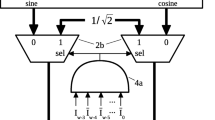Abstract
Systems which are computationally complex often include the calculation of sine/cosine values, which frequently uses its Taylor series expansion. For high accuracy the Taylor series expansion becomes computationally intensive. Therefore, the calculation of sine (or cosine) values may become the bottleneck of the system. In this paper, a novel concept is proposed that employs dynamic master–user look-up table (DMU-LUT) configuration for the calculation of trigonometric values with user defined precision. Initially, samples on a unit circle are evaluated at regular interval of \(\Phi \), where \(\Phi \) denotes the sampling angle. This results in \(2\pi \Phi \) total number of samples for creation of master table. The values of sine/cosine are calculated at each sample and then stored in the master table. The application-specific user table is obtained by three proposed sampling scenarios (constant distance, section, and probabilistic sampling) of master table. The main advantage of this scheme is to provide flexibility to achieve the desired accuracy according to system requirements. For FPGA implementations of user table, \(7{\times} \) delay improvement and 48% reduced components utilization has been observed while achieving better accuracy over high speed combinational CORDIC algorithm.




Similar content being viewed by others
Data Availibility
Enquiries about data availability should be directed to the authors.
References
Volder, J. (1959). The cordic computing technique. In Papers presented at the the March 3–5, 1959, Western joint computer conference (pp. 257–261).
Hu, Y. H. (1992). Cordic-based VLSI architectures for digital signal processing. IEEE Signal Processing Magazine, 9(3), 16–35.
Harber, R. G., Hu, X., Li, J., & Bass, S. C. (1988). The application of bit-serial cordic computational units to the design of inverse kinematics processors. In Proceedings. 1988 IEEE international conference on robotics and automation (pp. 1152–1157). IEEE.
Valls, J., Sansaloni, T., Pérez-Pascual, A., Torres, V., & Almenar, V. (2006). The use of cordic in software defined radios: A tutorial. IEEE Communications Magazine, 44(9), 46–50.
Duprat, J., & Muller, J.-M. (1993). The cordic algorithm: New results for fast VLSI implementation. IEEE Transactions on Computers, 42(2), 168–178.
Cordesses, L. (2004). Direct digital synthesis: A tool for periodic wave generation (part 1). IEEE Signal Processing Magazine, 21(4), 50–54.
Meher, P. K., Valls, J., Juang, T.-B., Sridharan, K., & Maharatna, K. (2009). 50 years of cordic: algorithms, architectures, and applications. IEEE Transactions on Circuits and Systems I: Regular Papers, 56(9), 1893–1907.
Salazar, A., Bahubalindruno, G., Locharla, G., Mendonça, H., Alves, J., & Da Silva, J. (2011). A study on look-up table based sine wave generation. In Proceedings of the Regional Echomail Coordinator, Porto, Portugal (pp. 3–4).
Kathewadi, S. (2009). FSCA: Fast sine calculating algorithm. In 2009 IEEE international advance computing conference (pp. 165–170). IEEE.
Funding
The authors have not disclosed any funding.
Author information
Authors and Affiliations
Corresponding author
Ethics declarations
Conflict of interest
The authors declare that they have no known competing financial interests or personal relationships that could have appeared to influence the work reported in this paper.
Additional information
Publisher's Note
Springer Nature remains neutral with regard to jurisdictional claims in published maps and institutional affiliations.
Rights and permissions
About this article
Cite this article
Satti, P., Sharma, N., Singh, G. et al. A Flexible Dynamic Master–User Look-Up Table Approach for Evaluation of Trigonometric Values. Wireless Pers Commun 127, 3425–3434 (2022). https://doi.org/10.1007/s11277-022-09924-3
Accepted:
Published:
Issue Date:
DOI: https://doi.org/10.1007/s11277-022-09924-3




